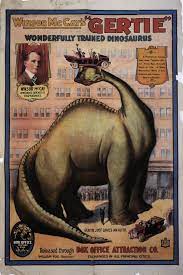
Several noted film creators are out for a drive. They have a blow-out in front of a museum. While the flat tire is being fixed, the guys go into the museum. There they see a dinosaur skeleton and meet Winsor McCay. One of the men in the party is George McManus. McCay makes a bet with McManus that he can make the dinosaurs come to life by the use of a series of hand-drawn cartoons. The loser must pay for dinner for everyone there. After six months, McCay has the cartoons completed. McCay tells McManus that he created 10,000 cartoons, each one a little different from the other. During the dinner McCay shows his film.
The film begins with the drawing of a cave. McCay calls to the dinosaur to come out. The dinosaur is named Gertie. Cautiously the shy dinosaur comes out and faces the audience. McCay has Gertie bow and do tricks for the viewers. Gertie gets distracted by a sea serpent in a nearby lake and a mammoth that walks on screen. Gertie tosses the mammoth into the water and does a little dance. The mammoth sprays Gertie with water. Gertie throws a rock at him and takes a nap. When she wakes up, McCay continues to have the sweet and playful dinosaur entertain the guests.
“Gertie the Dinosaur” was released in 1914 and is the creation of American cartoonist and animator Winsor McCay. It is an animated short that runs about 12 minutes. It is not the first animated film, but it is the first to feature a dinosaur.
The film originally ran only about six minutes. McCay used the film as part of his vaudeville act. McCay's employer, William Randolph Hearst, was not happy about McCay's vaudeville activities. McCay added the live action beginning and theatrically released the film. The movie is now about 12 minutes long with the added footage.
Gertie was the first film to use animation techniques such as keyframes, registration marks, tracing paper, the Mutoscope action viewer, and animation loops. McCay’s young son, Robert, plays his clumsy assistant who scatters a bunch of drawings all over the floor.
In 1991 “Gertie the Dinosaur” was preserved in the U.S. Library of Congress' National Film Registry as being "culturally, historically, or aesthetically significant".
In 1915, cartoonist John Randolph Bray plagiarized McCay’s work and created his own “Gertie the Dinosaur”. The fake Gertie film often ended up inaccurately being represented as the real one in documentaries. Bray also stole McCay’s animation techniques and patented them himself. Then he sued McCay for using them. McCay prevailed since he could prove that he had been using those very same techniques way before the fake Gertie made its appearance.
Around 1921 McCay started working on a sequel to Gertie called “Gertie on Tour”. Only two minutes of film was produced before the project was abandoned.
Gertie the Dinosaur
Fake Gertie the Dinosaur
Gertie On Tour

